|
|
|
TMB Optical 152 triplet apo refractor by Thomas M. Back, mounted on AP-1200GTO mount |
TMB Optical 152/1200mm OTA OPTICAL ANALYSIS
Wade
Van Arsdale
Little Rock, AR., USA
March 23rd, 2010
|
|
|
TMB Optical 152 triplet apo refractor by Thomas M. Back, mounted on AP-1200GTO mount |
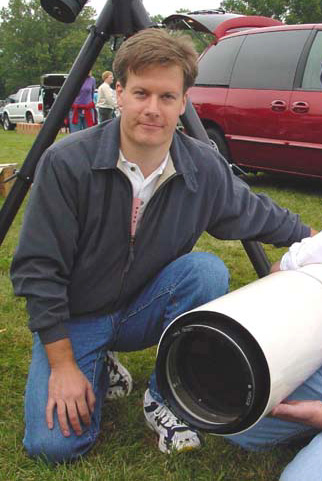 |
Note: with the
untimely and unfortunate passing of Thomas M. Back, the brand-name TMB Optical triplet apo
refractors using Russian LZOS OK-4 glass are no longer available through
Tom's company. Tom was
recognized as an authority on optical design and was respected worldwide for his
expertise and outstanding contributions to the fields of astronomy and optical
design. Not only was Tom without peer in his field, he was also known
for his kindness, humility, and sincerity to his many friends and those in the
astronomy community whom he crossed paths with. For his loyal customers and everyone who knew him or
worked with him, he is and will
continue to be greatly missed. Rest in peace Tom. |
| Thomas M. Back, 1957-2007 |
I. TMB 152 Optical Analysis:
Strehl and Wavefront Error Testing
Test
Dates: March 22-23, 2010
Skies: Clear
Seeing: 6 out of 10, with some interference in atmospheric steadiness from
jet-stream
Transparency: 9 out of 10
Temperature: 47 degrees F
Dewpoint: 44 degrees
Wind: N, 5-10 mph
Test camera: Lumenera SKYnyx 2-2C webcam with Baader IR/UV cutoff filter @
320 x 240 image size, 41 fps capture rate for 1000 frames each, and resolution
of 0.75 arc-sec/pixel
Optical Analysis Software Used: WinRoddier
The TMB-152 tested out with an excellent Strehl value of 0.970, as measured mid-bandwidth in the Green (approximately 550 nm wavelength). This corresponds to a P-V wavefront error of approximately 1/10th wave at the camera chip, which is outstanding. Considering that a P-V value of 1/4 wave is considered to be diffraction-limited, 1/10th wave is outstanding, and significantly beyond diffraction-limited in optical performance. This means that in all types of atmospheric seeing conditions no matter how good, the telescope's performance will only be limited by the atmospheric seeing itself and never limited by the telescope's optics. Overall, the TMB-152 tested out as an excellent performer both visually and for deep-sky imaging as well as for planetary webcamming.
A
note about OTA cooldown with the TMB 152:
This
OTA uses a phenolic type of compound for the tube instead of standard T6061
aluminum or other type of aluminum. It is important to take the time
necessary to cool down the optics
and tube properly on this model. To get the results shown below on the
Strehl tests, I had to use forced cooling with a Lymax Cosmic One "cat
cooler" fan system for internal heat dissipation inside the OTA. I
also pulled back the sliding dewcap to expose the lens elements to cooling
better. I ran the Lymax fan for 30 minutes (the maximum
recommended by Lymax) prior to testing the optics. Without the fan,
this model can take up to 2 hours to properly cool down. Without
the fan and with a cooldown period of 30 minutes, the Strehl in Green
(reference bandwidth) tested at 0.940. After an equal time of 30 minutes
on the Lymax
fan for the second session, I was able to get the
0.970 Strehl in Green shown below. These differences indicate that with
this refractor it is crucial to allow a proper cooldown period for top
performance of the optics. Forced-cooling with a fan may also help speed
up the cooldown times.
See Roddier tests below for each individual wavelength specifics.
Reference Chart for Strehl Values and P-V Wavefront Errors. Chart courtesy of R.F. Royce Precision Optical Components:
|
Commonly Encountered Wavefront Relationships |
||||
| P-V Fraction | P-V Decimal | Marechal RMS* | Strehl Ratio | Comments |
| 1/3 | .333 | .094 | .71 | |
| 1/4 | .250 | .071 | .82 | Rayleigh Limit |
| 1/5 | .200 | .057 | .88 | |
| 1/6 | .167 | .047 | .92 | Good |
| 1/7 | .143 | .041 | .94 | Very Good |
| 1/8 | .125 | .036 | .95 | Excellent |
| 1/9 | .111 | .032 | .960 (.96) | Excellent |
| 1/10 | .100 | .028 | .969 (.97) | Excellent |
| 1/11 | .091 | .026 | .974 | |
| 1/12 | .024 | .024 | .978 | "Super Apo" |
Strehl
Test Results:
Green
(reference): Ronchigram (white
test pattern below) shows almost perfect correction and an excellent
Strehl value of 0.970, which corresponds to an outstanding wavefront error
of only 1/10th wave. Based on the data, this refractor should be an
excellent planetary scope with very low levels of spherical aberration.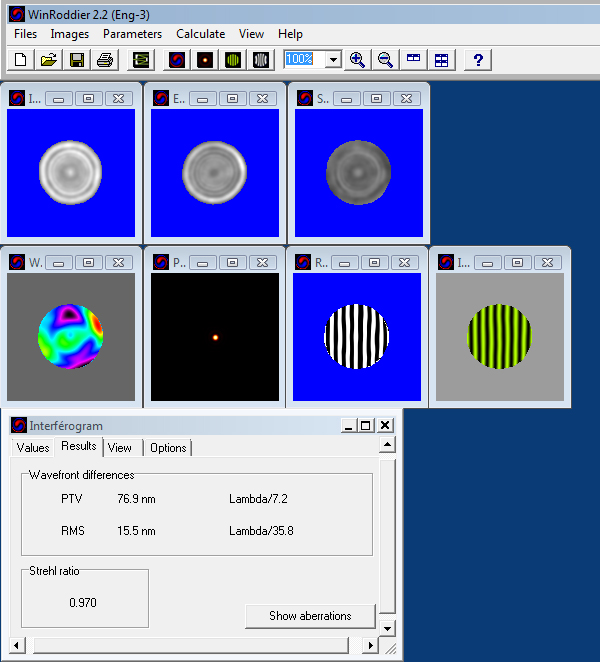 |
Red:
Ronchigram shows some very slight undercorrection
in the red wavelengths. Slight undercorrection is usually not a
problem because it tends to correct itself to some extent as the glass
cools down to equilibrium with outdoor ambient temperature. The
Strehl value recorded is 0.940 which is very good and corresponds to 1/7th
wave P-V.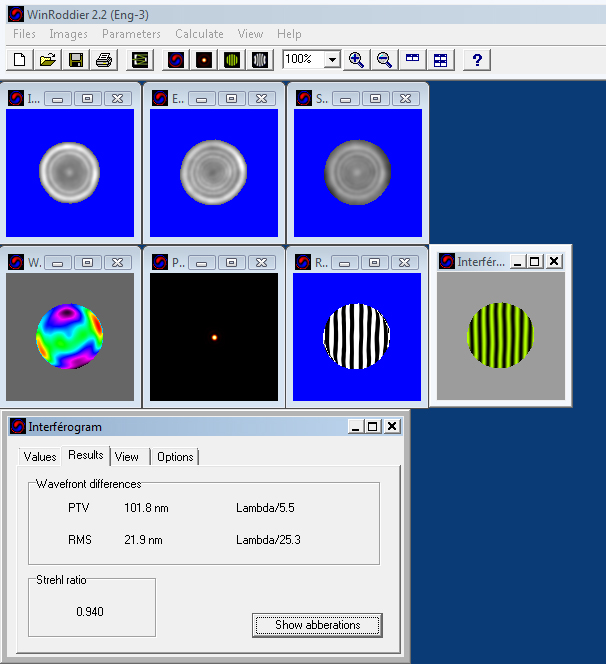 |
Blue:
Basically no under or overcorrection present
in the blue. A little bit of tube thermals present likely caused the
rougher Ronchigram figure in the blue. The Strehl value recorded is
0.950 which is excellent. The correction in blue should stay
close to this level as the scope further equalizes.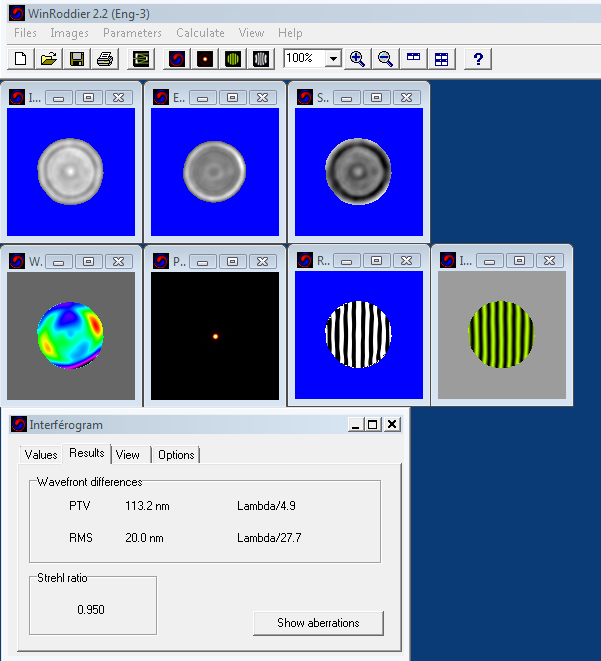 |
II. Hi-resolution webcam images of Jupiter and Saturn with the TMB-152:
Camera: Lumenera SKYnyx 2-2C webcam with Baader IR/UV cutoff filter
|
|
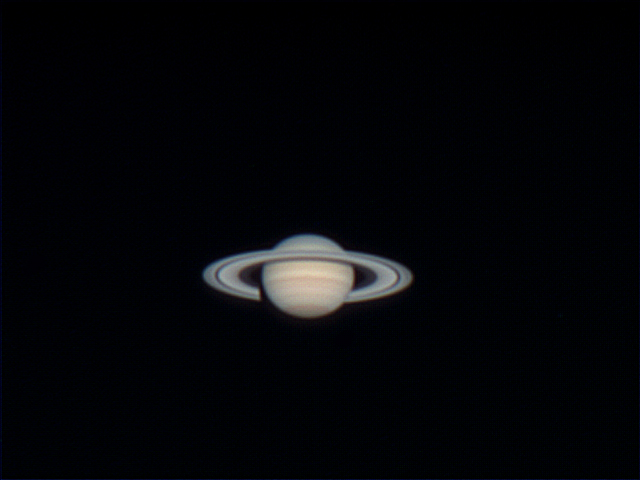 |
III. Collimation Testing
Equipment Used:
SBIG ST-2000XM CCD Camera.
SBIG CFW8 filter wheel. All CCDI test frames shot through Custom Scientific
(L-layer) clear filter with IR cutoff.
TMB Optical 152/1200mm OTA
Mount Used: Astro-Physics AP1200GTO
Collimation method used: Takahashi Collimator Scope with artificial
light source.
CCD
Inspector Software by CCDWare
Curvature, Tip/Tilt, and Collimation all very
good and produced round stars
across the entire FOV.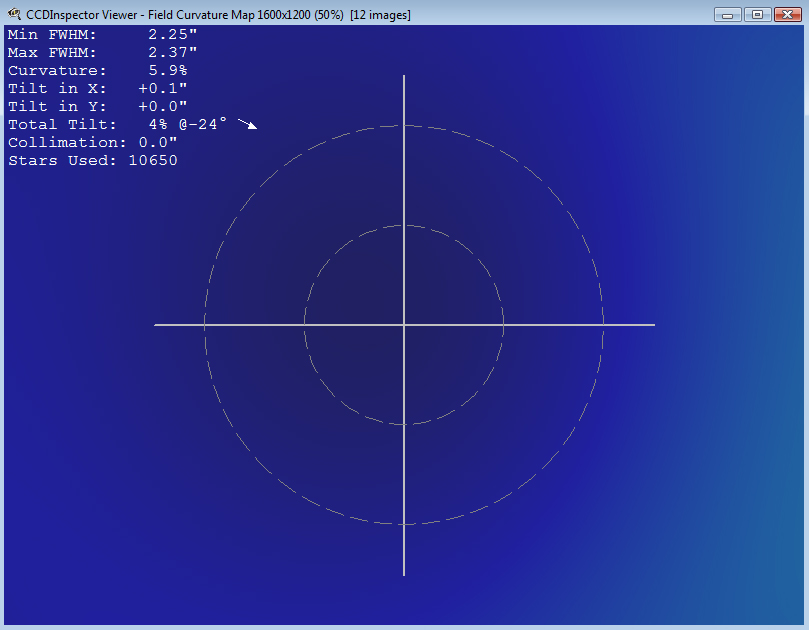 |
Frames used for analysis. FWHM shows non-optimal but workable seeing
conditions for the tests.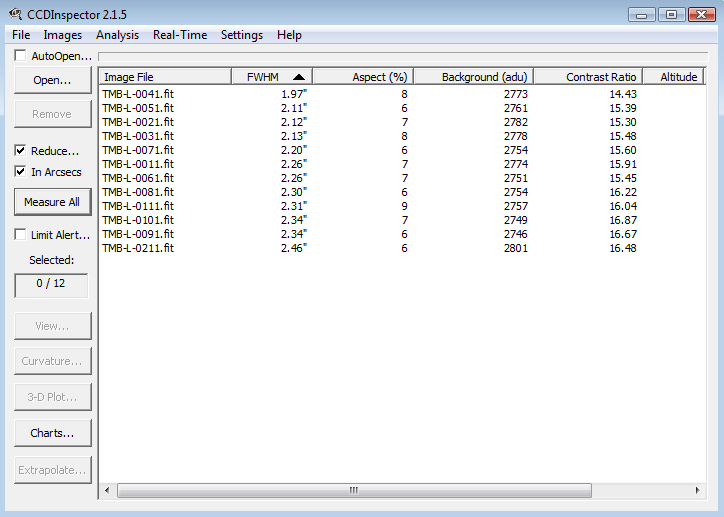 |
|
Field curvature value of 5.9% is
low on the 15mm image cone diameter provided by the CCD chip used for the
test, indicating exceptional glass figuring quality and workmanship on the
Russian LZOS objective lens glass. No field flattener or reducer was
used on the TMB for any of these tests. You would however need an
add-on field-flattener with APS-C (28mm) or larger-diameter image cone
sizes). |
IV. High-Resolution Deep Sky Image Tests: M12 Globular Cluster
(Note, this image was affected by atmospheric turbulence which softened the focus considerably. I did not use processing tools to reduce star bloat in this image so we could examine a "worst-case" scenario that is encountered often in real-life imaging when higher-resolution focal lengths are used like this telescope delivers. While this image does not allow proper visual evaluation of spherical aberration due to the poor atmospherics, it does still allow for chromatic aberration evaluation. Focal point shift of the R, G, B color wavelengths and resultant color fringing on the stars from CA is non-existent in this image. This telescope shows no visually detectable chromatic aberration at all).
 |
Image Details:
Conclusion:
The
TMB Optical 152/1200 triplet apo arrived here very well collimated and in
excellent overall mechanical and cosmetic condition from the TMB Optical shop.
Its objective elements are made by LZOS in Russia, using OK4 extra-low
dispersion glass for the ED center element. The telescope showed
outstanding control of chromatic aberration in the test imaging run, with very
sharp focus and no star haloing, color fringing, or loss of focus in the blue
bandwidth or any other color bandwidths. The TMB-152 also showed almost
nonexistent levels of spherical aberration on the visual star test. This
telescope has an excellent performance level for high-resolution CCD imaging.
It is also an excellent planetary and deep-sky visual scope that can take high
magnification very well in good atmospheric seeing conditions.
Wade Van Arsdale
Little Rock, AR., USA
Latest edit: Jan 1st, 2020